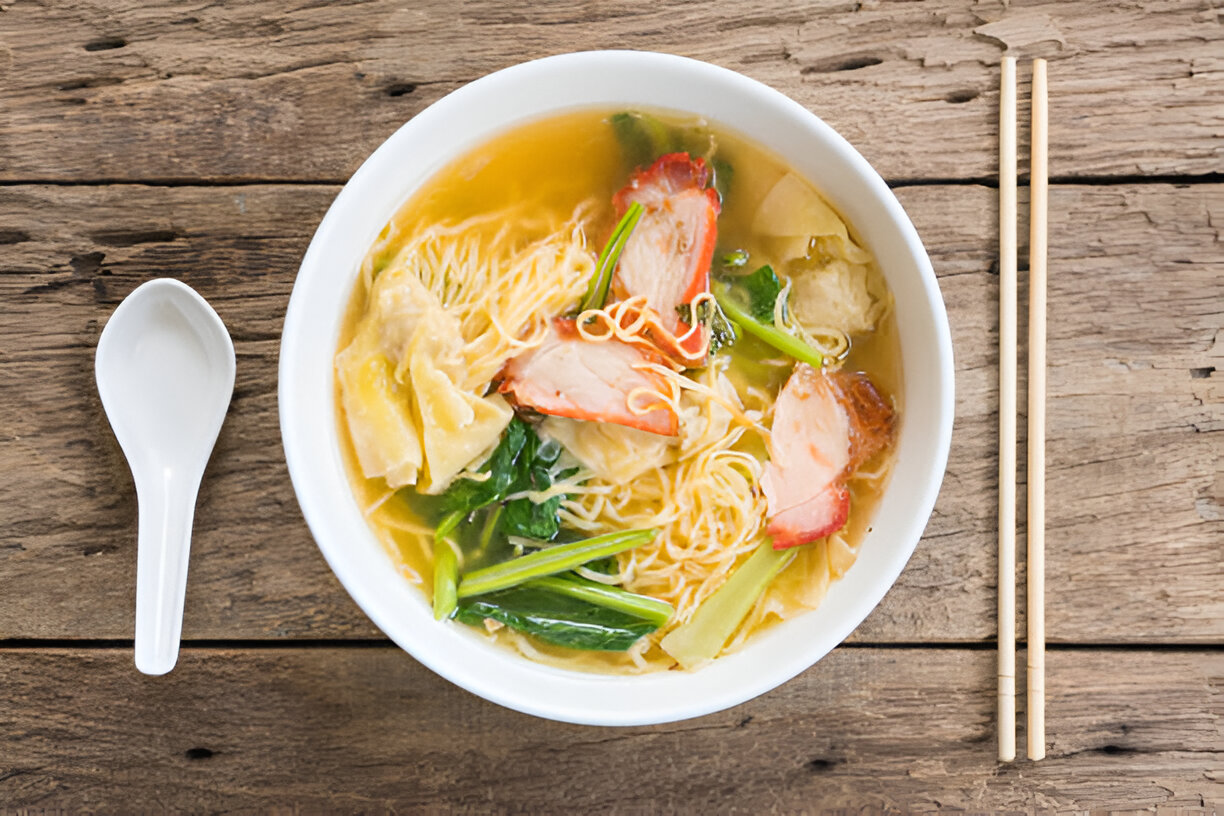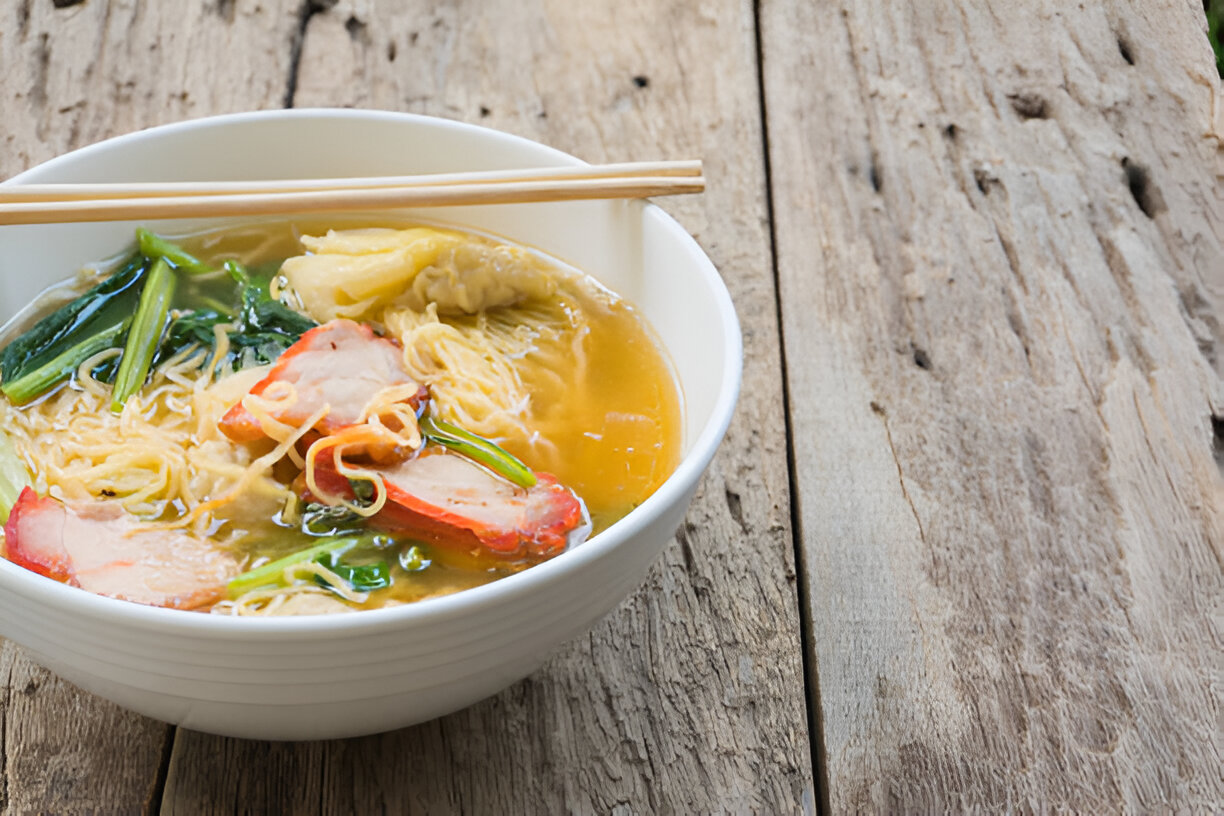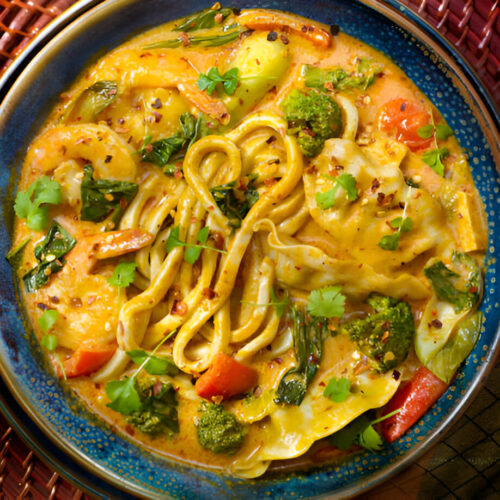Thai Red Curry Dumpling Soup: A Flavorful Delight to Try
Thai cuisine is a vibrant and diverse culinary tradition that is cherished worldwide for its bold flavors and fresh ingredients. Characterized by its delicate balance of sweet, salty, spicy, and sour notes, Thai dishes create an exciting gastronomic experience that captivates the palate. Among the myriad dishes that define this cuisine, Thai red curry stands out with its rich, aromatic essence, derived from a harmonious blend of ingredients such as red chili, garlic, lemongrass, and coconut milk. Each component contributes to a flavor profile that is both complex and comforting, making it a favorite among many food enthusiasts.
The concept of dumpling soup brings a delightful twist to traditional soup recipes, merging the heartiness of broth with the satisfying texture of dumplings. By combining the savory aspects of Thai red curry with tender dumplings, this dish encapsulates the essence of Thai cooking while adding a unique comfort food element. Thai Red Curry Dumpling Soup has gained popularity not only for its exquisite taste but also for the versatility it offers, allowing for variations in ingredients and spice levels to cater to diverse preferences.

Understanding Thai Red Curry
Thai red curry, known as “Gaeng Phed,” is a cornerstone of Thai cuisine, celebrated for its vibrant aroma and rich, bold flavors. The origins of this culinary delight trace back to central Thailand, where the use of fresh local ingredients shaped the dish’s unique character. At its core, Thai red curry is defined by the use of red curry paste, which is made from a variety of ingredients that may include red chili peppers, garlic, shallots, lemongrass, and shrimp paste, all ground together to create a fragrant base. This blend is then simmered with coconut milk for a creamy texture that balances the heat of the spices.
The flavor profile of Thai red curry is a beautiful symphony of tastes—sweet, spicy, salty, and sour. The creamy coconut milk softens the heat of the chilies, while the addition of tamarind or lime juice often introduces a tangy brightness that enhances the overall experience. This complexity makes Thai red curry not just a dish, but a journey through layers of flavor that highlight the versatility and richness of Thai cuisine.
Health Benefits of Red Curry
Besides its delightful taste, Thai red curry offers several health benefits thanks to its key ingredients. Primarily composed of vegetables, herbs, and lean proteins, this dish contributes valuable nutrients to one’s diet. For instance, red chilies are rich in vitamin C and capsaicin, a compound known for its anti-inflammatory and metabolism-boosting properties. Garlic and lemongrass are both packed with antioxidants, which are essential for combating free radicals in the body.
Moreover, the use of coconut milk provides healthy fats that can promote heart health and assist with nutrient absorption. This creamy base is also a source of medium-chain triglycerides (MCTs), which some studies suggest may have beneficial impacts on weight management and energy levels. By incorporating fresh vegetables and lean proteins, Thai red curry not only satisfies cravings but also serves as a nutritious and wholesome meal option, making it a delightful balance between indulgence and health.

The Art of Dumplings
Dumplings are a beloved aspect of Thai cuisine, adding unique flavors and textures to dishes. They are versatile and come in various forms, each with its distinctive characteristics. From traditional Thai wontons to fried potstickers, dumplings can be filled with an array of ingredients, including meats, vegetables, and seafood, making them a perfect match for the rich and aromatic Thai red curry.
Types of Dumplings Used in Thai Cuisine
- Thai Wontons: Typically made with thin, round wrappers, these dumplings can be filled with seasoned ground meat or vegetables.
- Potstickers: Pan-fried on one side to create a crispy texture, potstickers are often filled with minced pork or chicken accompanied by vegetables.
- Silken Dumplings: Made with a delicate dough, these are steamed and can harbor various fillings, often including shrimp or fish.
Each type of dumpling plays a crucial role in Thai cuisine, providing delightful contrasts to the bold flavors of the soup. Whether steamed, boiled, or fried, dumplings are not just a component; they are an experience to savor.
Making Dumplings from Scratch
Creating homemade dumplings can be a rewarding endeavor, allowing for personalization of flavors and ingredients. The dough is a key element, and while store-bought wrappers are convenient, making them from scratch elevates the dish.
To prepare the dough, combine flour and water until it forms a smooth consistency. Allow it to rest for about 30 minutes before rolling it out into thin circles. This process helps achieve a perfect texture for the dumplings.
Common fillings usually consist of a mixture of ground meat, such as pork or chicken, along with chopped vegetables like cabbage, mushrooms, and cilantro for added flavor.
Thai Red Curry Dumpling Soup Recipe
Ingredients
- For the Soup Base:
- Coconut milk
- Thai red curry paste
- Vegetable or chicken broth
- Fish sauce
- Lime juice
- For the Dumplings:
- Dumpling wrappers or made-from-scratch dough
- Filling ingredients (e.g., protein, vegetables, herbs)
Directions
Preparing the Soup Base
Begin by heating a large pot over medium heat. Add two tablespoons of the Thai red curry paste and sauté it for a minute until fragrant. Gradually stir in the coconut milk, allowing it to blend smoothly with the curry paste. Pour in the vegetable or chicken broth, bringing the mixture to a gentle simmer.
Season the broth with fish sauce and a squeeze of lime juice, balancing the flavors. Let it simmer for about 10 minutes to let the ingredients meld, and set aside while you prepare the dumplings.
Making the Dumplings
Take the prepared dough and roll it out on a floured surface into thin sheets. Cut out circles or squares, and spoon a small amount of filling onto the center of each wrapper. Moisten the edges with water, then fold over and crimp to seal tightly, ensuring no filling escapes.
Repeat the process until all the dumplings are filled. You can steam or boil the dumplings for about 5–7 minutes, or until fully cooked. If desired, pan-fry them for an additional crispy exterior, enhancing the texture.
Cooking the Soup
Once the dumplings are ready, gently place them in the simmering soup base. Cook for an additional 5-7 minutes, allowing the dumplings to soak up the daring flavors of the red curry broth. Adjust seasoning as necessary, adding more fish sauce or lime juice to your liking.
Cooking Tips and Advice
For those looking to mix things up, consider variations in your dumpling fillings. Try using different proteins like shrimp or tofu, or incorporate fresh herbs like mint or basil for a unique twist. Adjusting the spice level of the red curry paste can also cater to various palates; simply add less for a milder soup.
If you encounter issues such as dumplings tearing, ensure the dough is well-kneaded and not too dry. Meanwhile, for a thinner soup consistency, gradually add more broth while simmering.
Garnish your soup with fresh cilantro, sliced chilies, or a drizzle of lime juice for added freshness and a pop of color before serving.
Serving Suggestions
Pair Thai Red Curry Dumpling Soup with a bowl of jasmine rice for added heartiness, or enjoy it with a fresh side salad to balance the rich flavors. Presentation is key; serve the soup in a deep bowl adorned with vibrant garnishes that entice the eyes.
For beverages, opt for traditional drinks such as Thai iced tea, known for its sweet and creamy texture, or a refreshing mango lassi that complements the dish’s spiciness.
Common Variations and Adaptations
Vegetarian/Vegan Options
For those following a vegetarian or vegan diet, consider substituting meat fillings with a robust mixture of seasonal vegetables or tofu. Ensure you choose vegan-friendly dumpling wrappers or make your own using plant-based ingredients.
Gluten-Free Options
To cater to gluten-free diets, look for specialized gluten-free wrappers or create your own using alternative flours like rice or tapioca flour. Adapt the recipe for dumplings to ensure a delightful experience without compromising flavor.
Frequently Asked Questions (FAQs)
What does Thai red curry taste like?
Thai red curry is characterized by a complex flavor profile that is sweet, spicy, salty, and sour, creating a harmonious balance that excites the palate.
Can I use store-bought dumplings?
Absolutely! Store-bought dumplings can save time and are a great option if you’re short on time, although homemade can add a personal touch.
How spicy is Thai red curry?
The spiciness of Thai red curry largely depends on the amount of red curry paste used. You can adjust the heat to your preference by varying the quantity.
How do I store leftovers?
Leftover soup can be stored in an airtight container in the refrigerator for up to three days. Reheat gently on the stove, adding a splash of broth if needed.
What can I substitute for coconut milk?
If you need a substitute, almond milk or soy milk can work, but they will alter the flavor. For a richer alternative, try using cashew or oat milk.
Conclusion
Incorporating the rich flavors of Thai red curry and the comforting texture of dumplings, this recipe for Thai Red Curry Dumpling Soup offers a delightful experience that showcases the beauty of Thai cuisine. We encourage you to try this dish in your kitchen and share your delightful culinary experiences with others.

Thai Red Curry Dumpling Soup
Equipment
- 1 large pot
- 1 stove
- 1 mixing bowl
- 1 whisk
- 1 ladle
Ingredients
- 1 tablespoon vegetable oil
- 1 medium onion, chopped
- 3 cloves garlic, minced
- 1 tablespoon fresh ginger, grated
- 3 tablespoons red curry paste Adjust for more or less heat according to preference.
- 4 cups chicken or vegetable broth For a vegetarian version, use vegetable broth.
- 1 can (14 oz) coconut milk
- 1 tablespoon soy sauce
- 1 tablespoon lime juice
- 2 cups fresh spinach
- 12 pieces homemade or store-bought dumplings
- to taste fresh cilantro, for garnish
- to serve lime wedges
Instructions
- Heat the vegetable oil in a large pot over medium heat. Add the chopped onion and sauté for about 5 minutes until it becomes translucent.
- Stir in the minced garlic and grated ginger. Cook for an additional 1-2 minutes until fragrant.
- Add the red curry paste to the pot and stir for another minute, ensuring it's well incorporated.
- Pour in the chicken or vegetable broth and bring to a gentle simmer.
- Once simmering, add the coconut milk, soy sauce, and lime juice. Stir well to combine.
- Carefully place the dumplings into the soup. Cook according to the dumpling packaging instructions, usually about 5-7 minutes or until they are fully cooked.
- Stir in the spinach and cook for an additional 1-2 minutes until wilted.
- Taste and adjust seasoning if necessary.
- Serve hot, garnished with fresh cilantro and lime wedges on the side.

